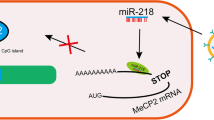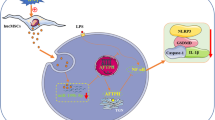Abstract
Bone marrow-derived mesenchymal stem cells (BMSCs) exert protective effects against pulmonary ischemia/reperfusion (I/R) injury; however, the potential mechanism involved in their protective ability remains unclear. Thus, this study aimed to explore the function and underlying mechanism of BMSC-derived exosomal lncRNA-ZFAS1 in pulmonary I/R injury. Pulmonary I/R injury models were established in mice and hypoxia/reoxygenation (H/R)-exposed primary mouse lung microvascular endothelial cells (LMECs). Exosomes were extracted from BMSCs. Target molecule expression was assessed by qRT-PCR and Western blotting. Pathological changes in the lungs, pulmonary edema, apoptosis, pro-inflammatory cytokine levels, SOD, MPO activities, and MDA level were measured. The proliferation, apoptosis, and migration of LMECs were detected by CCK-8, EdU staining, flow cytometry, and scratch assay. Dual-luciferase reporter assay, RNA pull-down, RIP, and ChIP assays were performed to validate the molecular interaction. In the mouse model of pulmonary I/R injury, BMSC-Exos treatment relieved lung pathological injury, reduced lung W/D weight ratio, and restrained apoptosis and inflammation, whereas exosomal ZFAS1 silencing abolished these beneficial effects. In addition, the proliferation, migration inhibition, apoptosis, and inflammation in H/R-exposed LMECs were repressed by BMSC-derived exosomal ZFAS1. Mechanistically, ZFAS1 contributed to FOXD1 mRNA decay via interaction with UPF1, thereby leading to Gal-3 inactivation. Furthermore, FOXD1 depletion strengthened the weakened protective effect of ZFAS1-silenced BMSC-Exos on pulmonary I/R injury. ZFAS1 delivered by BMSC-Exos results in FOXD1 mRNA decay and subsequent Gal-3 inactivation via direct interaction with UPF1, thereby attenuating pulmonary I/R injury.









Similar content being viewed by others
Availability of Data and Material
All data generated or analyzed during this study are included in this published article.
Abbreviations
- ANOVA:
-
Analysis of variance
- BMSC-Exos:
-
BMSC-derived exosomes
- BMSCs:
-
Bone marrow-derived MSCs
- CCK-8:
-
Cell counting kit 8
- ChIP:
-
Chromatin immunoprecipitation
- DAPI:
-
4′-6-Diamidino-2-phenylindole
- EdU:
-
5-Ethynyl-2′-deoxyuridine
- FBS:
-
Fetal bovine serum
- FOXD1:
-
Forkhead box D1
- Gal-3:
-
Galectin-3
- H&E:
-
Hematoxylin and eosin
- HLA-DR:
-
Human leukocyte antigen DR
- H/R:
-
Hypoxia/reoxygenation
- Hsp70:
-
Heat shock protein
- I/R:
-
Ischemia/reperfusion
- LMECs:
-
Lung microvascular endothelial cells
- lncRNAs:
-
Long non-coding RNAs
- MEG3:
-
Maternally expressed gene 3
- MSCs:
-
Mesenchymal stem cells
- NTA:
-
Nanoparticle tracking analysis
- PBS:
-
Phosphate-buffered saline
- PTBP1:
-
Polypyrimidine tract-binding protein 1
- qRT-PCR:
-
Quantitative real-time PCR
- RBPs:
-
RNA-binding proteins
- RIP:
-
RNA immunoprecipitation
- shNC:
-
Negative control shRNA
- TSG101:
-
Tumor susceptibility gene 101
- TUNEL:
-
Terminal deoxynucleotidyl transferase-mediated dUTP nick end-labeling
- UPF1:
-
Up-frameshift 1
- W/D:
-
Wet/dry
- XIST:
-
X-inactive-specific transcript
- ZFAS1:
-
Zinc finger antisense 1
- ZFPM2-AS1:
-
Zinc finger protein multitype 2 antisense RNA 1
References
den Hengst WA, Gielis JF, Lin JY, Van Schil PE, De Windt LJ, Moens AL (2010) Lung ischemia-reperfusion injury: a molecular and clinical view on a complex pathophysiological process. Am J Physiol Heart Circ Physiol 299(5):H1283-1299. https://doi.org/10.1152/ajpheart.00251.2010
Porteous MK, Diamond JM, Christie JD (2015) Primary graft dysfunction: lessons learned about the first 72 h after lung transplantation. Curr Opin Organ Transplant 20(5):506–514. https://doi.org/10.1097/MOT.0000000000000232
Pak O, Sydykov A, Kosanovic D, Schermuly RT, Dietrich A, Schroder K, Brandes RP, Gudermann T, Sommer N, Weissmann N (2017) Lung ischaemia-reperfusion injury: the role of reactive oxygen species. Adv Exp Med Biol 967:195–225. https://doi.org/10.1007/978-3-319-63245-2_12
Laubach VE, Sharma AK (2016) Mechanisms of lung ischemia-reperfusion injury. Curr Opin Organ Transplant 21(3):246–252. https://doi.org/10.1097/MOT.0000000000000304
Nakajima D, Watanabe Y, Ohsumi A, Pipkin M, Chen M, Mordant P, Kanou T, Saito T, Lam R, Coutinho R, Caldarone L, Juvet S, Martinu T, Iyer RK, Davies JE, Hwang DM, Waddell TK, Cypel M, Liu M, Keshavjee S (2019) Mesenchymal stromal cell therapy during ex vivo lung perfusion ameliorates ischemia-reperfusion injury in lung transplantation. J Heart Lung Transplant 38(11):1214–1223. https://doi.org/10.1016/j.healun.2019.07.006
Podesta MA, Remuzzi G, Casiraghi F (2020) Mesenchymal stromal cell therapy in solid organ transplantation. Front Immunol 11:618243. https://doi.org/10.3389/fimmu.2020.618243
Lazar E, Benedek T, Korodi S, Rat N, Lo J, Benedek I (2018) Stem cell-derived exosomes - an emerging tool for myocardial regeneration. World J Stem Cells 10(8):106–115. https://doi.org/10.4252/wjsc.v10.i8.106
Raposo G, Stoorvogel W (2013) Extracellular vesicles: exosomes, microvesicles, and friends. J Cell Biol 200(4):373–383. https://doi.org/10.1083/jcb.201211138
Li JW, Wei L, Han Z, Chen Z (2019) Mesenchymal stromal cells-derived exosomes alleviate ischemia/reperfusion injury in mouse lung by transporting anti-apoptotic miR-21-5p. Eur J Pharmacol 852:68–76. https://doi.org/10.1016/j.ejphar.2019.01.022
Massa M, Croce S, Campanelli R, Abba C, Lenta E, Valsecchi C, Avanzini MA (2020) Clinical applications of mesenchymal stem/stromal cell derived extracellular vesicles: therapeutic potential of an acellular product. Diagnostics (Basel) 10(12):E999. https://doi.org/10.3390/diagnostics10120999
Quinn JJ, Chang HY (2016) Unique features of long non-coding RNA biogenesis and function. Nat Rev Genet 17(1):47–62. https://doi.org/10.1038/nrg.2015.10
Statello L, Guo CJ, Chen LL, Huarte M (2021) Gene regulation by long non-coding RNAs and its biological functions. Nat Rev Mol Cell Biol 22(2):96–118. https://doi.org/10.1038/s41580-020-00315-9
Yao RW, Wang Y, Chen LL (2019) Cellular functions of long noncoding RNAs. Nat Cell Biol 21(5):542–551. https://doi.org/10.1038/s41556-019-0311-8
Li J, Wei L, Han Z, Chen Z, Zhang Q (2020) Long non-coding RNA X-inactive specific transcript silencing ameliorates primary graft dysfunction following lung transplantation through microRNA-21-dependent mechanism. EBioMedicine 52:102600. https://doi.org/10.1016/j.ebiom.2019.102600
Jiang Y, Zhang W (2021) LncRNA ZFAS1 plays a role in regulating the inflammatory responses in sepsis-induced acute lung injury via mediating miR-193a-3p. Infect Genet Evol 92:104860. https://doi.org/10.1016/j.meegid.2021.104860
Pan L, Liang W, Fu M, Huang ZH, Li X, Zhang W, Zhang P, Qian H, Jiang PC, Xu WR, Zhang X (2017) Exosomes-mediated transfer of long noncoding RNA ZFAS1 promotes gastric cancer progression. J Cancer Res Clin Oncol 143(6):991–1004. https://doi.org/10.1007/s00432-017-2361-2
Zhang L, Yang Z, Trottier J, Barbier O, Wang L (2017) Long noncoding RNA MEG3 induces cholestatic liver injury by interaction with PTBP1 to facilitate shp mRNA decay. Hepatology 65(2):604–615. https://doi.org/10.1002/hep.28882
Azzalin CM, Lingner J (2006) The human RNA surveillance factor UPF1 is required for S phase progression and genome stability. Curr Biol 16(4):433–439. https://doi.org/10.1016/j.cub.2006.01.018
Li CH, Chang YC, Hsiao M, Liang SM (2019) FOXD1 and Gal-3 form a positive regulatory loop to regulate lung cancer aggressiveness. Cancers (Basel) 11(12):E1897. https://doi.org/10.3390/cancers11121897
Eslaminejad MB, Nadri S (2009) Murine mesenchymal stem cell isolated and expanded in low and high density culture system: surface antigen expression and osteogenic culture mineralization. In Vitro Cell Dev Biol Anim 45(8):451–459. https://doi.org/10.1007/s11626-009-9198-1
Zeng Q, Zhou Y, Liang D, He H, Liu X, Zhu R, Zhang M, Luo X, Wang Y, Huang G (2020) Exosomes secreted from bone marrow mesenchymal stem cells attenuate oxygen-glucose deprivation/reoxygenation-induced pyroptosis in PC12 cells by promoting AMPK-dependent autophagic flux. Front Cell Neurosci 14:182. https://doi.org/10.3389/fncel.2020.00182
Stephens RS, Rentsendorj O, Servinsky LE, Moldobaeva A, Damico R, Pearse DB (2010) cGMP increases antioxidant function and attenuates oxidant cell death in mouse lung microvascular endothelial cells by a protein kinase G-dependent mechanism. Am J Physiol Lung Cell Mol Physiol 299(3):L323-333. https://doi.org/10.1152/ajplung.00442.2009
Sharma AK, Charles EJ, Zhao Y, Narahari AK, Baderdinni PK, Good ME, Lorenz UM, Kron IL, Bayliss DA, Ravichandran KS, Isakson BE, Laubach VE (2018) Pannexin-1 channels on endothelial cells mediate vascular inflammation during lung ischemia-reperfusion injury. Am J Physiol Lung Cell Mol Physiol 315(2):L301–L312. https://doi.org/10.1152/ajplung.00004.2018
Xu Y, Li X, Cheng Y, Yang M, Wang R (2020) Inhibition of ACSL4 attenuates ferroptotic damage after pulmonary ischemia-reperfusion. FASEB J 34(12):16262–16275. https://doi.org/10.1096/fj.202001758R
Wang M, Ji P, Wang R, Zhao L, Xia Z (2012) TRPV1 agonist capsaicin attenuates lung ischemia-reperfusion injury in rabbits. J Surg Res 173(1):153–160. https://doi.org/10.1016/j.jss.2010.08.053
Luo N, Liu J, Chen Y, Li H, Hu Z, Abbott GW (2018) Remote ischemic preconditioning STAT3-dependently ameliorates pulmonary ischemia/reperfusion injury. PLoS One 13(5):e0196186. https://doi.org/10.1371/journal.pone.0196186
Silva AM, Teixeira JH, Almeida MI, Goncalves RM, Barbosa MA, Santos SG (2017) Extracellular Vesicles: Immunomodulatory messengers in the context of tissue repair/regeneration. Eur J Pharm Sci 98:86–95. https://doi.org/10.1016/j.ejps.2016.09.017
Dong H, Wang W, Chen R, Zhang Y, Zou K, Ye M, He X, Zhang F, Han J (2018) Exosome-mediated transfer of lncRNASNHG14 promotes trastuzumab chemoresistance in breast cancer. Int J Oncol 53(3):1013–1026. https://doi.org/10.3892/ijo.2018.4467
Chen Q, Liu Y, Ding X, Li Q, Qiu F, Wang M, Shen Z, Zheng H, Fu G (2020) Bone marrow mesenchymal stem cell-secreted exosomes carrying microRNA-125b protect against myocardial ischemia reperfusion injury via targeting SIRT7. Mol Cell Biochem 465(1–2):103–114. https://doi.org/10.1007/s11010-019-03671-z
Zhang Y (2020) lncRNA ZFAS1 improves neuronal injury and inhibits inflammation, oxidative stress, and apoptosis by sponging miR-582 and upregulating NOS3 expression in cerebral ischemia/reperfusion injury. Inflammation 43(4):1337–1350. https://doi.org/10.1007/s10753-020-01212-1
Janakiraman H, House RP, Gangaraju VK, Diehl JA, Howe PH, Palanisamy V (2018) The Long (lncRNA) and short (miRNA) of It: TGFbeta-mediated control of RNA-binding proteins and noncoding RNAs. Mol Cancer Res 16(4):567–579. https://doi.org/10.1158/1541-7786.MCR-17-0547
Dehecq M, Decourty L, Namane A, Proux C, Kanaan J, Le Hir H, Jacquier A, Saveanu C (2018) Nonsense-mediated mRNA decay involves two distinct Upf1-bound complexes. EMBO J 37 (21). e99278 https://doi.org/10.15252/embj.201899278
Han S, Cao D, Sha J, Zhu X, Chen D (2020) LncRNA ZFPM2-AS1 promotes lung adenocarcinoma progression by interacting with UPF1 to destabilize ZFPM2. Mol Oncol 14(5):1074–1088. https://doi.org/10.1002/1878-0261.12631
Hannenhalli S, Kaestner KH (2009) The evolution of Fox genes and their role in development and disease. Nat Rev Genet 10(4):233–240. https://doi.org/10.1038/nrg2523
Mu L, Zhang J, Wu Z, Huang J, Cui Y (2022) FOXD1 Regulates the sensitivity of cetuximab by regulating the expression of EGFR in head and neck squamous cell cancer. J Healthc Eng 2022:6108241. https://doi.org/10.1155/2022/6108241
Bond KH, Fetting JL, Lary CW, Emery IF, Oxburgh L (2021) FOXD1 regulates cell division in clear cell renal cell carcinoma. BMC Cancer 21(1):312. https://doi.org/10.1186/s12885-021-07957-8
Lin L, Peng SL (2006) Coordination of NF-kappaB and NFAT antagonism by the forkhead transcription factor Foxd1. J Immunol 176(8):4793–4803. https://doi.org/10.4049/jimmunol.176.8.4793
Meng F, Liu Y, Chen Q, Ma Q, Gu S, Cui R, Cao R, Zhao M (2020) METTL3 contributes to renal ischemia-reperfusion injury by regulating Foxd1 methylation. Am J Physiol Renal Physiol 319(5):F839–F847. https://doi.org/10.1152/ajprenal.00222.2020
Perillo NL, Marcus ME, Baum LG (1998) Galectins: versatile modulators of cell adhesion, cell proliferation, and cell death. J Mol Med (Berl) 76(6):402–412. https://doi.org/10.1007/s001090050232
Liu FT (2005) Regulatory roles of galectins in the immune response. Int Arch Allergy Immunol 136(4):385–400. https://doi.org/10.1159/000084545
Liu FT, Hsu DK (2007) The role of galectin-3 in promotion of the inflammatory response. Drug News Perspect 20(7):455–460. https://doi.org/10.1358/dnp.2007.20.7.1149628
Sunil VR, Francis M, Vayas KN, Cervelli JA, Choi H, Laskin JD, Laskin DL (2015) Regulation of ozone-induced lung inflammation and injury by the beta-galactoside-binding lectin galectin-3. Toxicol Appl Pharmacol 284(2):236–245. https://doi.org/10.1016/j.taap.2015.02.002
Levin BS, Chang MG, Bittner EA (2021) Teleguidance technology for endotracheal intubation: a scoping review. Crit Care Explor 3(12):e0582. https://doi.org/10.1097/CCE.0000000000000582
Acknowledgements
We would like to give our sincere gratitude to the reviewers for their constructive comments.
Funding
This work was supported in part by Changzhou HighLevel Medical Talents Training Project (KY20221373 and KY20221357) and the Major Program of Science and Technology Project of Changzhou Health Commission (ZD202206).
Author information
Authors and Affiliations
Contributions
Cao Gao: Conceptualization, Writing-original draft preparation, Investigation, Validation, Visualization, Methodology.
Yan-Jie Xu: Software.
Zhi-xiu Meng: Methodology.
Shuang Gu: Data curation.
Lei Zhang: Visualization.
Liang Zheng: Conceptualization, Writing-original draft preparation, Supervision, Writing-reviewing and editing.
Corresponding author
Ethics declarations
Ethics Approval and Consent to Participate
The lungs were harvested after euthanasia by overdose of sodium pentobarbital. All procedures were approved by the Animal Care and Use Committee of the Third Affiliated Hospital of Soochow University.
Consent for Publication
The informed consent obtained from study participants.
Conflict of Interest
The authors declare no competing interests.
Additional information
Publisher's Note
Springer Nature remains neutral with regard to jurisdictional claims in published maps and institutional affiliations.
Rights and permissions
Springer Nature or its licensor (e.g. a society or other partner) holds exclusive rights to this article under a publishing agreement with the author(s) or other rightsholder(s); author self-archiving of the accepted manuscript version of this article is solely governed by the terms of such publishing agreement and applicable law.
About this article
Cite this article
Gao, C., Xu, YJ., Meng, Zx. et al. BMSC-Derived Exosomes Carrying lncRNA-ZFAS1 Alleviate Pulmonary Ischemia/Reperfusion Injury by UPF1-Mediated mRNA Decay of FOXD1. Mol Neurobiol 60, 2379–2396 (2023). https://doi.org/10.1007/s12035-022-03129-2
Received:
Accepted:
Published:
Issue Date:
DOI: https://doi.org/10.1007/s12035-022-03129-2




